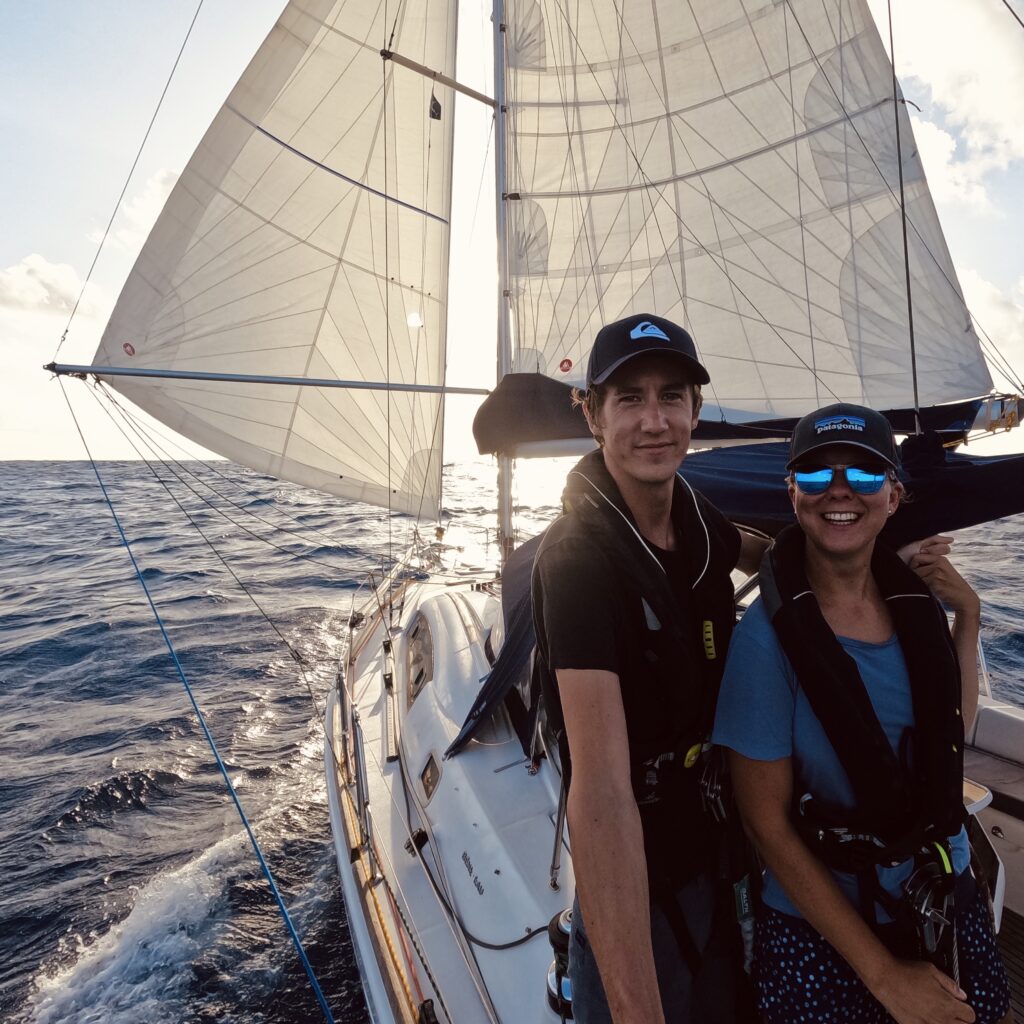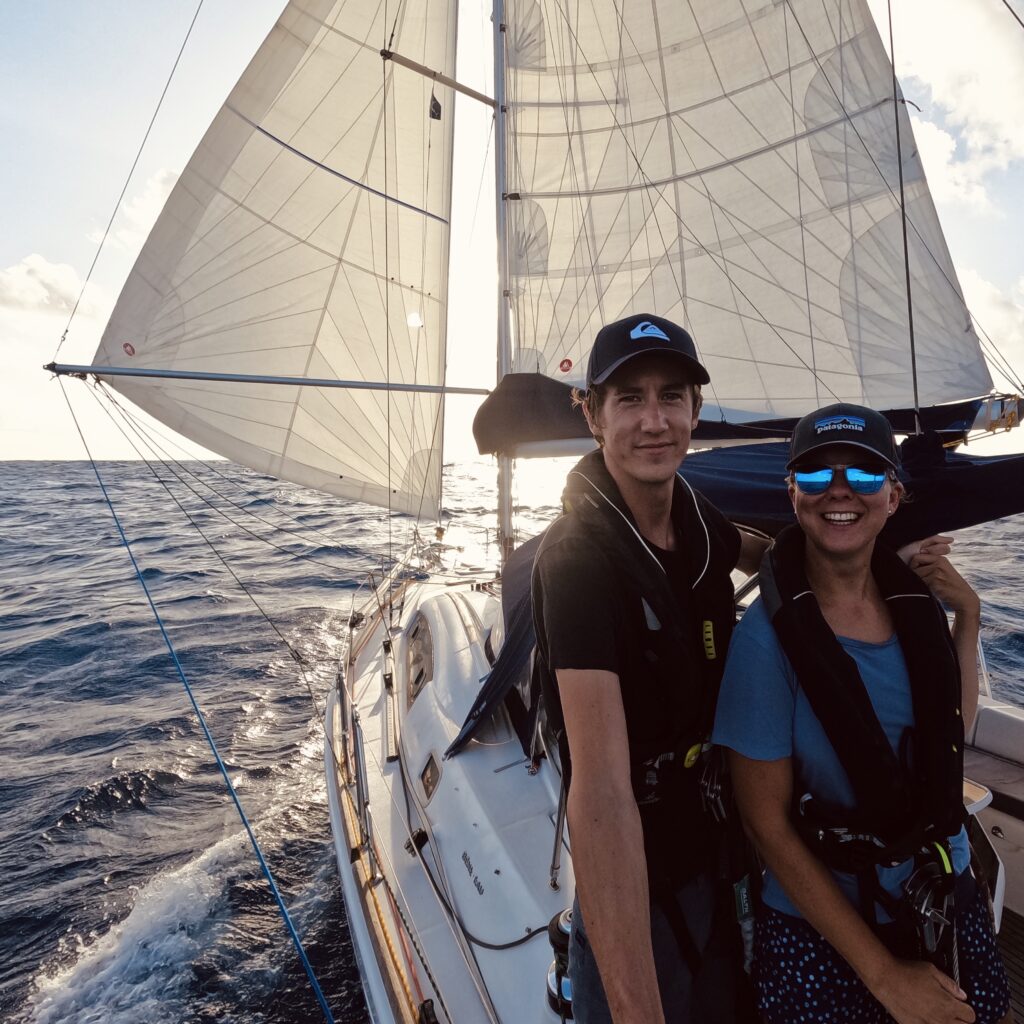Once we exited the Panama Canal it was both a great relief that this milestone was reached but also a sense of “point of no return”. Up until the canal transit we had always had the option that if the circumnavigation didn’t feel like our thing, we could also call it a Caribbean season and do the very common Atlantic circuit instead. Now though, we were out through the canal and it felt more definite that we just had to keep going west. We were definitely excited but the responsibility also felt greater. The waters would be more remote and the facilities and access to conveniences we were used to would be scarce.
We had understood that Panama City, where we now were after exiting the canal, would be our best place to stock up for the coming months. So we had some busy days of preparations and provisions ahead of us. Everything was very American and the range of goods was very good. However, the prices would vary a lot and a box of cereal would cost more than a taxi ride to the supermarket. And in the tropical climate, everything would go ripe in a matter of days if it hadn’t already started to go bad in the grocery store. We tried our best and we divided our provisioning efforts to different stores, hoping that a mix would cover our needs and give into the fact that fresh fruit and vegetables would not last long for this crossing. Frozen, dried and canned alternatives would have to suffice.
We carried out all our provisioning, boat preparations and admin to prepare for at least a month long crossing. All this while waiting for packages to arrive from Sweden, while the shipment wasn’t the tricky part the process of retrieving the packages from the local customs proved far more complicated than we ever had experienced.
When the packages finally arrived, we were quick to get going. It was the second to last day of a weather window which actually had a slight breeze. We wanted to catch as much as possible of it and let it take us as far west as possible. So after approximately four weeks in Panama we set off for the Pacific Ocean, looking forward to the calm passage life. Also keen to set off on our first double handed ocean passage, a more than 4000 NM ocean passage just the two of us with a continuous watch schedule of three hours on watch and three hours off watch .
We motored out the first two hours, zigzagging our way between all the big ships and fishing boats and once we were out we could set sail. On our cruise out, as the sight of land was slowly disappearing behind us, we had a visit from both a turtle and a shark. After approximately 24 hours our luck was out though, the wind died and the extremely frustrating bobbing started. The worst part being that we knew that this had been our chance. In hindsight we also realized that we had been a bit too focused on a westerly course and probably should have aimed a bit more south, as whichever winds that were to come traditionally fill in from the south.
Oh well, not much to do. Our only option was to take the small puffs of wind that came and make the best of them. When there was absolutely no wind whatsoever, we also allowed us a few occasional engine hours. Closely monitoring our diesel consumption though, always trying to be on the cautious side and aware that we didn’t know what we had to come and that we had a long and very remote crossing ahead of us.
We were heading straight to French Polynesia, more specifically the Marquesas Islands, and skipping the Galápagos Islands. While it would have been very cool to visit the Galápagos Islands, we had simply taken the decision that this would not fit in our budget. A stay there would equal the cost of 2-3 months of cruising with all the special permits, costs and actions such a stop would entail. We actually even learned that among sailors, a new and growing trend due to the increasing costs of a stop at the Galápagos Islands, was to leave the boat in Panama for a week and fly out to the Galápagos Islands, stay at a hotel and then fly back. Many times that had proved to be a cheaper option that sailing there.
Our course was however set for Galapagos, mostly as a precaution to pass by close to land in case anything were to happen and we would need to seek shelter. The winds were light for quite a few days but we had great company from the marine wildlife with both dolphin shows, whale encounters and a happy and splashy visit from two Orcas more more or less taking a jump just under our boom.
We struggled our way west, with light winds during the days and nights filled with lightning and thunder. We didn’t get much sleep and were constantly on our toes to do whatever we could to keep as far as possible from the lightning. Lightning and light shifty winds are a part of the notorious doldrums and while we had read about this in advance and knew that they were to come, we were very keen on doing whatever we could to escape them as soon as possible. We kept holding a south easterly course and eventually the winds would fill in more and more. After a few days the winds were steadier and we were heading upwind as we were making our way towards the Galápagos Islands.
During this upwind stretch we also had visitors onboard. It started off with one bird. At first we thought it was the matter of one lost bird that was desperate for a rest, he sat on our bow all day and night and we named him Billy. As the days passed though he had more and more friends joining him and soon we had a pack of birds fighting with each other over the best seats and they were pooping all over the boat. We spent our Easter scrubbing off bird poop from the solar panels (to avoid any disruption for the solar power) and we had quickly renamed the bird to “Billy the pooper”. Now we were very much looking forward to them leaving Puffin. They never seemed scared and didn’t budge if we came close or did sail changes on deck.
With Billy the pooper and his friends onboard we eventually crossed the Equator. A first for both of us and even though it was at 01:30 AM we were both up and celebrated with a drink and a bag of Swedish candy. We also made sure to make an offering to Neptune for good luck and customary when sailing across the equator.
Eight days into our crossing, just after the sun had set our wind instrument suddenly failed. It was as a switch went off and we couldn’t get any wind data any longer. We pulled out the flash light but couldn’t find any visible damage. We had nothing to do but sail without wind information during the night, hoping that the issue would prove more visible in daylight. Unfortunately our trouble shooting the next day didn’t provide any further answers. Luckily we actually did have a backup plan onboard! Back when we had upgraded the wind instrument we had kept the old one onboard, just in case. So after some digging in the deepest most inconvenient locations (since we, when putting it away, thought that we surely wouldn’t need it) we could dig out the old wind instrument and temporarily install it on our solar arch. While the data wouldn’t be as accurate, this would give us an indication of the wind speed.
As the wind instrument was installed and up and running, we could once again get back in to our routine. The next day we were happily distracted from all wind instrument issues when we saw one huge whale after the other passing Puffin. They were huge and passed just by us. While we (okay, maybe mostly Charlotte) was a bit freaked out that they were bigger than Puffin and just a few meters away from us, they weren’t the least bit interested in us. Somehow we must have crossed there migration path or something, because for the rest of the day they kept passing us (to the extent that if they were more than a few meters from us, it wasn’t reason enough to call on each others attention – yes, quickly spoiled by the amazing wildlife). And actually close whale encounters were reoccurring during the crossing, some closer than others and whales in different sizes. Some would lazily just swim past us while some would play and mess around in the wake from Puffin for quite a while and showing up on either side of us to dive down under and come up on the other side and loop back.
As we eventually were just south of the Galápagos Islands, this is both when the winds started to turn to a more favorable angle and Billy and his friends all of a sudden decided that their hitchhike was done and flew off. Slowly but surely the trade winds started to fill in and we could finally set course towards our actual goal meaning that we could finally see the miles to our destination steadily decrease.
After 19 days at sea we had a halfway celebration (halfway in the number of miles, not time wise – luckily) with small bottle of Cava and as the good reads, books, podcasts etc. were running out, we eagerly continued to monitor the number of miles remaining. The big excitements of the days were the incoming e-mails from friends and family. Max’s mother kindly sent news updates more or less daily, and these were a very popular read when the views were the constant blue seas and seeing another boat on the AIS becoming more of a weekly occasion.
As we were finally getting closer, celebrating every milestone we could come up with to make the day special the weather was also making sure we didn’t relax quite yet. Our last 500 NM were filled with extremely shifting conditions, where the wind speed could triple from one second to the other without a cloud or telltale in sight. We had to be on our toes and were waking each other up for reefs and sail changes several times. It was as if the weather really tried to tell us not to relax before we were actually there.
Eventually, after 33 days at sea, we could finally say “land ahoy” as we were approaching the Marquesas. Nuku Hiva, the only island open for clearance procedures due to the pandemic, towered up with its majestic green volcanic hills and we could navigate in to Taiohae, drop anchor and prepare the celebratory Gin & Tonic.
Cheers to a successful Pacific crossing!



